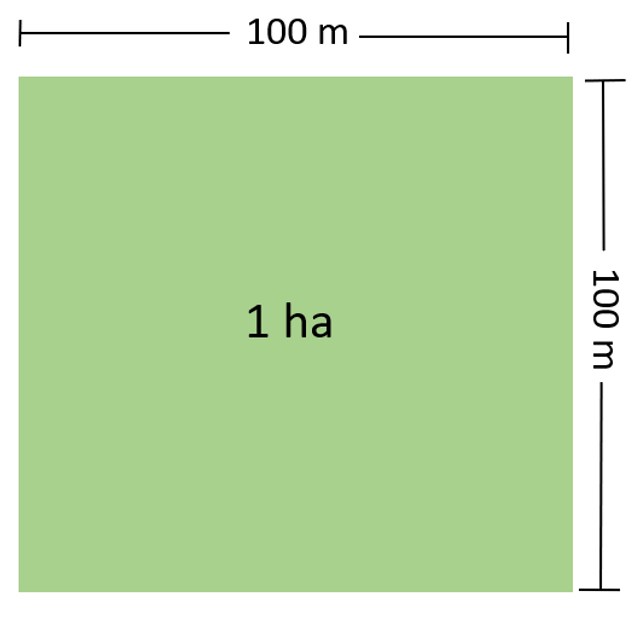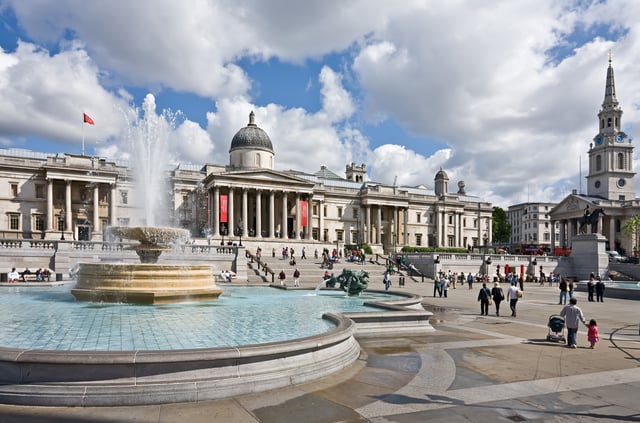Hectare

Hectare

| Hectare | |
|---|---|
| General information | |
| Unit system | Non-SI unit accepted for use with SI |
| Unit of | Area |
| Symbol | ha |
| InSI base units: | 1 ha = 10 m |
The hectare (/ˈhɛktɛər, -tɑːr/; SI symbol: ha) is an SI accepted metric system unit of area equal to a square with 100-metre sides, or 10,000 m2, and is primarily used in the measurement of land.[1] There are 100 hectares in one square kilometre. An acre is about 0.405 hectare and one hectare contains about 2.47 acres.
In 1795, when the metric system was introduced, the "are" was defined as 100 square metres and the hectare ("hecto-" + "are") was thus 100 "ares" or 1⁄100 km2 (10,000 square metres). When the metric system was further rationalised in 1960, resulting in the International System of Units (SI), the are was not included as a recognised unit. The hectare, however, remains as a non-SI unit accepted for use with the SI units, mentioned in Section 4.1 of the SI Brochure as a unit whose use is "expected to continue indefinitely".[1]
The name was coined in French, from the Latin ārea.[2]
| Unit | SI |
|---|---|
| 1 ca | 1 m2 |
| 1 a | 100 m2 |
| 1 ha | 10,000 m2 |
| 100 ha | 1,000,000 m21 km2 |
| non-SI comparisons | |
| non-SI | metric |
| 0.3861 sq mi | 1 km2 |
| 2.471 acre | 1 ha |
| 107,639 sq ft | 1 ha |
| 1 sq mi | 259.0 ha |
| 1 acre | 0.4047 ha |
| Hectare | |
|---|---|
| General information | |
| Unit system | Non-SI unit accepted for use with SI |
| Unit of | Area |
| Symbol | ha |
| InSI base units: | 1 ha = 10 m |
History
The metric system of measurement was first given a legal basis in 1795 by the French Revolutionary government. The law of 18 Germinal, Year III (7 April 1795) defined five units of measure:[3]
In 1960, when the metric system was updated as the International System of Units (SI), the are did not receive international recognition. The International Committee for Weights and Measures (CIPM) makes no mention of the are in the current (2006) definition of the SI, but classifies the hectare as a "Non-SI unit accepted for use with the International System of Units".[5]
In 1972, the European Economic Community (EEC) passed directive 71/354/EEC,[6] which catalogued the units of measure that might be used within the Community. The units that were catalogued replicated the recommendations of the CGPM, supplemented by a few other units including the are (and implicitly the hectare) whose use was limited to the measurement of land.
Units

Definition of a hectare and of an are
The names centiare, deciare, decare and hectare are derived by adding the standard metric prefixes to the original base unit of area, the are.
Centiare
The centiare is one square metre.
Deciare
The deciare is ten square metres.
Are
The are (/ɑːr/[7] or /ɛər/[8]) is a unit of area, equal to 100 square metres (10 m × 10 m), used for measuring land area. It was defined by older forms of the metric system, but is now outside the modern International System of Units (SI).[9] It is still commonly used in colloquial speech to measure real estate, in particular in Indonesia, India, and in various European countries.
In Russian and other languages of the former Soviet Union, the are is called sotka (Russian: сотка: 'a hundred', i.e. 100 m2 or 1⁄100 hectare). It is used to describe the size of suburban dacha or allotment garden plots or small city parks where the hectare would be too large.
Decare
The decare (/ˈdɛkɑːr, -ɛər/) is derived from deca and are, and is equal to 10 ares or 1000 square metres. It is used in Norway[10] and in the former Ottoman areas of the Middle East and the Balkans (Bulgaria)[11] as a measure of land area. Instead of the name "decare", the names of traditional land measures are usually used, redefined as one decare:
Hectare

Trafalgar Square has an area of about one hectare.[14]
The hectare (/ˈhɛktɛər, -tɑːr/[15]), although not a unit of SI, is the only named unit of area that is accepted for use within the SI.[16] In practice the hectare is fully derived from the SI, being equivalent to a square hectometre. It is widely used throughout the world for the measurement of large areas of land, and it is the legal unit of measure in domains concerned with land ownership, planning, and management, including law (land deeds), agriculture, forestry, and town planning throughout the European Union.[17] The United Kingdom,[18] United States, Burma,[19][20] and to some extent Canada use the acre instead.
Some countries that underwent a general conversion from traditional measurements to metric measurements (e.g. Canada) required a resurvey when units of measure in legal descriptions relating to land were converted to metric units. Others, such as South Africa, published conversion factors which were to be used particularly "when preparing consolidation diagrams by compilation".[21]
In many countries, metrication redefined or clarified existing measures in terms of metric units.
The following legacy units of area have been redefined as being equal to one hectare:[22]
Conversions
| Metric equivalents | Imperial/US customary equivalents | ||||
|---|---|---|---|---|---|
| centiare | ca | 1 m2 | 0.01 a | 1.19599sq yd | |
| are | a[26] | 100 ca | 100 m2 | 0.01 ha | 3.95369perches |
| decare | daa | 10 a | 1,000 m2 | 0.1 ha | 0.98842roods |
| hectare | ha[1] | 100 a | **10,000 m2** | **0.01 km2** | about 2.4710538 acres |
| square kilometre | km2 | 100 ha | 1,000,000 m2 | 0.38610sq mi | |
The most commonly used units are in bold.
One hectare is also equivalent to:
Visualising a hectare
See also
Conversion of units
Hectometre
Order of magnitude